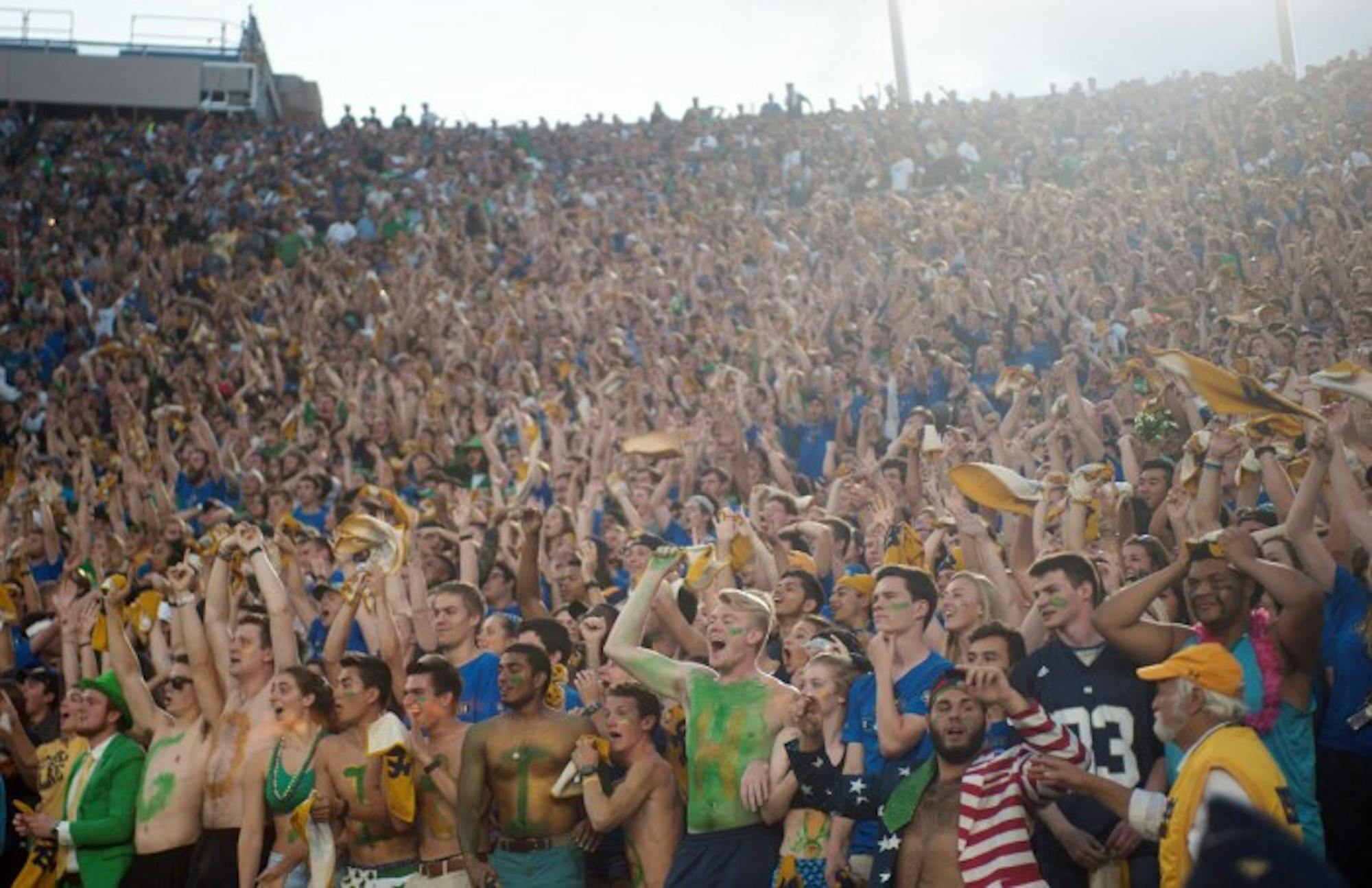
When football fans return to Notre Dame Stadium this September for the 2017 season opener against Temple, they’ll notice plenty of changes brought about by the Campus Crossroads project. The long-debated video board will make its debut, seats will be wider in the lower bowl, Wi-Fi will work throughout the stadium and the visiting team will enter through a new tunnel in the northeast corner.
But despite all the aesthetic alterations, the biggest change to the Notre Dame gameday experience might come somewhere else: in fans’ bank accounts.
Traditionally, Notre Dame has charged the same price for any bench seat in the stadium bowl, no matter whether that seat is in the lower or upper bowl, at the 50-yard line or in the corner. That will change in 2017, however, with the University announcing Saturday morning that it will break from that decades-long practice to institute a new tiered ticketing system.
Instead of a single price for all bench seats, there will be eight general-admission price points moving forward — four in the lower bowl, four in the upper — for each Irish football game in Notre Dame Stadium. The result is a decrease in the get-in price, dropping from $75 for any seat against Nevada to $45 for three opponents next season: Temple, Miami (Ohio) and Wake Forest.
“There’s almost a question of fairness to give the people who have seats that aren’t as in much of a prime location a lower price than those who are on the 50-yard line,” University spokesperson Dennis Brown said in an interview with The Observer on Tuesday.
The cheapest seats will be in the upper bowl’s end zone, where single-game tickets will cost $45, $65 or $95 based on the opponent — Georgia and USC will be the most expensive in 2017 — while the most expensive seats will be in the lower bowl’s three middle sections, with tickets costing between $145 for the cheapest games and $250 for the marquee opponents.
Season ticket plans will follow a similar structure, with those seats starting at $400 — plus a $750 required gift — in the “upper end” sections, rising to a $3,000 ticket-and-gift cost in the “lower prime” areas. Though the Irish will play seven times at home this year — due to the lack of a Shamrock Series game — season tickets will be priced for just the standard six games.
Students will see a minor decrease in their costs, too, with the price for student season tickets dropping from $245 to $240.
While seat prices along the sidelines are increasing, the decreases in the corners and end zone means Notre Dame won’t be adding revenue under the new system.
The University had three key concerns, Rob Kelly, assistant athletic director of ticketing and technology, said: an affordable get-in price, an affordable season ticket and staying revenue-neutral against last year’s figures.
“There were three goals … that we really wanted to hold to as we thought about constructing this model,” Kelly said in the interview. “One was holding an affordable price point that would ensure access for as broad as possible a population to the Notre Dame family. The second was continuing to be able to offer a deeply discounted student season ticket. And the third was that, regardless of the changes that we were making in the bowl, that we strived to keep the revenue from the bowl revenue-neutral from the 2016 season.”
Ticket prices will stay the same for the 2017 and 2018 seasons, Kelly said.
The change in ticketing structure will also affect the lottery system; Kelly said winners for games will be given a time to enter the system, with the choice of not only a price point, but also their specific seat.
“This may be the most significant change that we’re making in the process, is that with this coming year, participants in the lottery won’t just get to express a preference, you will actually select your seats,” Kelly said. “Given the new technology that we’re deploying, you will have the opportunity to select your seat location and preferred price point, based on availability.”
Season ticket members will gain new benefits in 2017, including free parking in White Field and complimentary entry to the Blue-Gold Game on April 22.
While the majority of the seating changes will take place in the lower bowl this offseason, the upper bowl will see changes, too, with an increase in ADA-accessible seating.
“Because we have an increasingly older demographic in our fanbase, we’re finding the needs for accessible seat locations is increasing,” Kelly said. “And we’re removing all the aluminum temporary benches, or stands, in the upper bowl to make way and make accommodation for additional ADA-accessible seat locations.”
Season-long seat holders will have the opportunity to stay in the same location or relocate to a new section to get to a desired price point — and since Notre Dame caps season tickets at 50 percent of capacity, Kelly expects no issues with ticket holders being able to sit where they want to.
“If there was any change in your seat, it would likely be nominal,” Kelly said. “If you’re on an aisle, we tried to keep you on an aisle. If you were in the first row, we tried to keep you in the first row. There were very few exceptions to that — because the seats that we pulled out, we could just pull out from the middle of the bench and then close everything in around it.”
The actual seats ticket holders sit in will be different, though. The wooden benches in the lower bowl will be ripped out and replaced with dark blue steel benches to match those in the upper bowl. The new seats will be two inches wider than their predecessors, expanding from 16 inches to 18, matching the width of the upper bowl’s seats.
Though the process of removing and replacing the benches will not be complete by the Blue-Gold Game in April and Commencement in May, Kelly said there will still be enough seating for the University to hold both events in the stadium.
The first opportunity to see the fully-finished stadium renovations will be in August, at the culminating event of the Notre Dame Trail pilgrimage celebrating the school’s 175th anniversary, vice president for public affairs and communication Paul Browne said.
An added benefit to the seat replacements is that season ticket holders will be able to buy pieces of the old wooden bench planks as a keepsake of the pre-Crossroads Notre Dame Stadium for their homes.
Another change will be visible around the playing surface itself, as all on-field seating will be removed to increase player safety, Kelly said. That means the on-field seating behind the south end zone will be removed, while the Band of the Fighting Irish will move to the front of the student section.
The new tunnel, added in the northeastern corner of the stadium for visiting teams to use entering and exiting the playing surface, will also contribute to the aesthetic changes fans will see in September.
All in all, capacity will decrease as part of the renovations — from 80,795 to a number near 78,000 — with around 7,000 seats being lost from the bowl and roughly 4,000 added in new premium seating areas, according to Kelly.
While season ticket holders may stay in the same seat location, their seat numbers will not remain the same. Notre Dame Stadium’s sections have historically been numbered such that one aisle runs down the middle of a section — meaning that seat 1 was in the middle of the section, not on the aisle — but in 2017, that will change, with one aisle serving two sections. As a result, seat 1 will always be on the aisle, and section numbers will shift a half-section counterclockwise, with sections 1 and 101 behind the north goal posts.
Of course, there are many changes fans will probably notice before the numbers of their seats — chief among them the 96-by-54-foot high-definition video board on the stadium’s south side.
The board will play live game action, important replays and spots about University achievements and initiatives, including the award-winning “What Would You Fight For?” series — but no advertisements. Brown noted the University “gives up a lot of money” by not opening up advertising opportunities, but the decision was made to help the Stadium retain a collegiate feel.
Other major technological changes include more than 150 video monitors placed around the stadium, a high-quality audio system, ribbon boards with game information, stronger cellular service and working Wi-Fi on a stadium-specific wireless network, Kelly said.
While the tailgating and football tradition fundamental to Notre Dame will remain the same, Kelly expects these updates, along with many smaller ones — renovated restrooms, new concourse and concession decorations — to greatly improve fans’ overall gameday experience.
“The Notre Dame gameday experience is something we obsess over, in a good way,” Kelly said. “We think about every interaction, from the usher telling you, ‘Welcome to Notre Dame,’ as you walk in, down to what do the graphics look like on the concessions cups, to what does the field look like? Details are important.”













